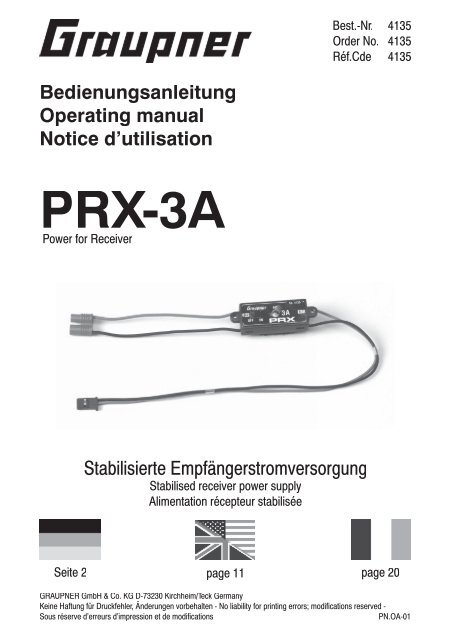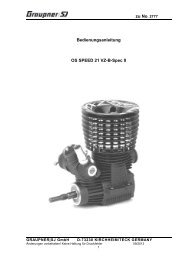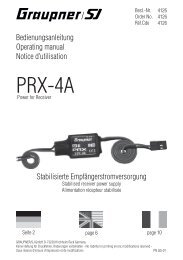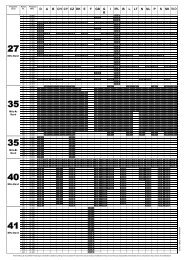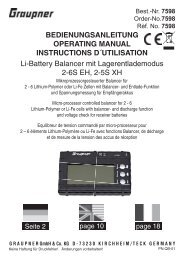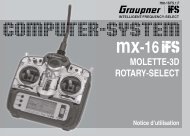You also want an ePaper? Increase the reach of your titles
YUMPU automatically turns print PDFs into web optimized ePapers that Google loves.
Best.-Nr.<br />
Order No.<br />
Réf.Cde<br />
4135<br />
4135<br />
4135<br />
Bedienungsanleitung<br />
Operating manual<br />
Notice d’utilisation<br />
<strong>PRX</strong>-<strong>3A</strong><br />
Power for Receiver<br />
Stabilisierte Empfängerstromversorgung<br />
Stabilised receiver power supply<br />
Alimentation récepteur stabilisée<br />
Seite 2 page 11 page 20<br />
GRAUPNER GmbH & Co. KG D-73230 Kirchheim/Teck Germany<br />
Keine Haftung für Druckfehler, Änderungen vorbehalten - No liability for printing errors; modifications reserved -<br />
Sous réserve d’erreurs d’impression et de modifications<br />
PN.OA-01
<strong>PRX</strong>-<strong>3A</strong> Power for Receiver<br />
Warnhinweise<br />
Herzlichen Glückwunsch zum Kauf der stabilisierten Empfängerstromversorgung <strong>PRX</strong> von<br />
<strong>Graupner</strong>. Eine erfolgreiche Anwendung setzt die Einhaltung bestimmter Grundsätze voraus.<br />
Lesen Sie bitte vor der Inbetriebnahme diese Bedienungsanleitung aufmerksam durch.<br />
- Das CE-Zertifikat dieses Gerätes entbindet nicht der Verpflichtung, äußerste Vorsicht zu<br />
wahren.<br />
- Verwenden Sie nur zur <strong>PRX</strong> passende Akkus von <strong>Graupner</strong> oder GM-Racing. Achten Sie<br />
hierbei auf die richtige Zellenzahl des Akkus und dessen Ausgangsspannung.<br />
- Wählen Sie an der <strong>PRX</strong> eine Ausgangsspannung, die für den angeschlossenen<br />
Empfänger und Servos geeignet ist (informieren Sie sich beim Hersteller der Komponenten).<br />
- Wählen Sie an der <strong>PRX</strong> vor dem Einschalten den richtigen Akkutyp aus, um die dazu<br />
passenden Betriebszustände des Gerätes angezeigt zu bekommen.<br />
- Akkus zum Laden immer von der <strong>PRX</strong> abstecken und am besten aus dem Modell nehmen.<br />
- Lassen Sie Ihr RC-Modell niemals unbeaufsichtigt, solange ein Akku angesteckt ist. Im Falle<br />
eines Defektes, könnte dies Feuer am Modell oder seiner Umgebung verursachen.<br />
- Die <strong>PRX</strong> oder andere elektronische Komponenten dürfen niemals mit Wasser in Berührung<br />
kommen. Die <strong>PRX</strong> ist vor Staub, Schmutz, Feuchtigkeit, Vibration, extreme Kälte oder<br />
Hitze und anderen Fremdteilen zu schützen.<br />
- Alle Kabel und Verbindungen sollen gut isoliert sein. Kurzschlüsse können zur Zerstörung<br />
der <strong>PRX</strong> führen. Anschlüssen nicht verpolen!<br />
- Nicht für Kinder unter 14 Jahren, kein Spielzeug!<br />
- Die <strong>PRX</strong> ist ausschließlich für den Einsatz in Akkubetriebenen, funkferngesteuerten Modellen<br />
vorgesehen, ein anderweitiger Betrieb ist nicht zulässig. Der Gebrauch in einem Modell zur<br />
Personenbeförderung ist verboten!<br />
- Motoren, Getriebe, Schiffs- oder Luftschrauben sind gefährliche Gegenstände. Halten Sie<br />
sich daher niemals neben oder vor dem Gefährdungsbereich des Antriebes auf!<br />
- Führen Sie immer zuerst einen Reichweitetest und Funktionstest am Boden durch (halten<br />
Sie dabei Ihr Modell fest), bevor Ihr Modell zum Einsatz kommt. Wiederholen Sie den Test<br />
bei laufendem Motor und mit kurzen Gasstößen.<br />
- Es dürfen keinerlei Veränderungen an der <strong>PRX</strong> durchgeführt werden.<br />
- Haftungsausschluss: Sowohl die Einhaltung der Montage- und Bedienungsanleitung, als auch<br />
die Bedingungen und Methoden bei Installation, Betrieb, Verwendung und Wartung der<br />
<strong>PRX</strong> können von der Fa. <strong>Graupner</strong> nicht überwacht werden. Daher übernimmt die<br />
Fa. <strong>Graupner</strong> keinerlei Haftung für Verluste, Schäden oder Kosten, die sich aus<br />
fehlerhafter Verwendung und Betrieb ergeben, oder in irgendeiner Weise damit<br />
zusammenhängen.<br />
Es dürfen nur von uns empfohlene Komponenten und Zubehörteile verwendet werden.<br />
Verwenden Sie nur zueinander passende, Original GRAUPNER - Steckverbindungen und<br />
Zubehörteile.<br />
2
<strong>PRX</strong>-<strong>3A</strong> Power for Receiver<br />
Allgemeine technische Merkmale<br />
Die Verwendung der <strong>PRX</strong> ermöglicht Ihnen den Einsatz von z.B. 2-zelligen LiPo/LiFe Akkus<br />
an Ihrem Empfänger (achten Sie auf die zulässige Betriebsspannung des Empfängers und der<br />
angeschlossenen Servos). Somit können sämtliche Vorteile der neuen Akkutechnologie genutzt<br />
werden. Servos und Empfänger werden durch eine stabilisierte Spannung versorgt um somit<br />
ihre volle Leistung zu entfalten. Spannungseinbrüche durch eventuell unterdimensionierte Akkus<br />
werden speichernd angezeigt.<br />
- Die Ausgangsspannung der <strong>PRX</strong> kann durch einen Drehschalter in drei Stufen gewählt<br />
und wenn nötig während des Betriebes umgestellt werden.<br />
5,1V | 5,5V | 5,9V<br />
können je nach Einsatzgebiet und Vorlieben des Piloten gewählt<br />
werden. Egal auf welcher Spannungslage sich die Akkus befinden, Empfänger und<br />
Servos werden mit einer stabilisierten Spannung versorgt um höchste und vor allem<br />
konstante Leistung unabhängig vom Ladezustand des Akkus zu erbringen.<br />
Die „Lebenszeit“ der Servos wird unter Umständen sogar erhöht, da diese nicht mit einer<br />
zu hohen Spannung (z.B. vollgeladene 5-zellige NiMH Akkus) betrieben werden.<br />
- 2-zellige LiPo<br />
2-zellige LiFe<br />
2-zellige LiIon<br />
5-zellige NiMH/NiCd und 6-zellige NiMH/NiCd Akkus können verwendet werden.<br />
Der Akkutyp muss vor dem Einschalten der <strong>PRX</strong> durch einen Drehschalter gewählt werden.<br />
- Für den Akku steht eine 2-farbige ultrahelle LED zur Verfügung um Betriebs- und<br />
Warnzustände eindeutig und einfach ablesbar anzuzeigen.<br />
- Der Ein- bzw. Ausschaltvorgang durch einen hochwertigen Wippschaltkontakt wird parallel<br />
mit einem elektronischen Schaltkreis gehalten, d.h. wenn eingeschaltet war, muss<br />
mechanisch definiert ausgeschalten werden. Bei einem Defekt des Schalters, ohne dass<br />
dabei explizit ausgeschaltet wird, bleibt die <strong>PRX</strong> eingeschalten.<br />
3
<strong>PRX</strong>-<strong>3A</strong> Power for Receiver<br />
Allgemeine technische Merkmale<br />
- Die <strong>PRX</strong> ist auf Basis eines Linearreglers aufgebaut, um im Gegensatz zu Schaltreglern<br />
keine unnötigen Störungen auf z.B. das Empfangssystem zu verursachen.<br />
- Der geradlinige Aufbau von Schalter, LED und Befestigungslöchern ermöglicht den<br />
einfachen und optisch ansprechenden Einbau in Ihr Modell.<br />
- Akkus mit folgenden Steckkontakten können ohne Löten durch beiliegende Adapterkabel<br />
verwendet werden.<br />
GRAUPNER|JR<br />
G2<br />
G3,5<br />
BEC<br />
- Um das Gerät zu schützen, wird eine Eingangsspannung über 9V durch einen<br />
Fehlercode angezeigt und der Ausgang schaltet nach einer Sekunde ab.<br />
- Bei Eingangsspannungen über 12V kann die <strong>PRX</strong> beschädigt werden.<br />
- Akkutypen: 2-zelliger LiPo<br />
2-zelliger LiFe<br />
2-zelliger LiIon<br />
5-zelliger NiMH/NiCd<br />
6-zelliger NiMH/NiCd<br />
- Eingangsspannung: 4V bis 9V (unter 4V kein stabiler Betrieb möglich)<br />
- Max. Eingangsspannung: 12V<br />
- Ruhestrom: ca. 0,3µA (ausgeschaltet)<br />
- Max. Dauerstrom: ca. <strong>3A</strong><br />
(für 1 MIN. bei LiPo 5,9V)<br />
- Max. Spitzenstrom: ca. 10A<br />
(für 1 SEK. bei LiPo 5,9V)<br />
- Max. Spitzenstrom: ca. 20A<br />
(für 100 MSEK. bei LiPo 5,9V)<br />
Die Angaben beziehen sich auf den Betrieb der <strong>PRX</strong> ohne aktive Kühlung durch z.B. umströmende<br />
Luft. Bei einer Kühlung liegen die Werte noch höher.<br />
- Gewicht: ca. 31g<br />
4
<strong>PRX</strong>-<strong>3A</strong> Power for Receiver<br />
Inbetriebnahme<br />
An dieser Stelle wird davon ausgegangen, dass Sie die komplette Anleitung, insbesondere bezüglich<br />
Hinweisen, Merkmalen, Spannungsbereiche und Akkutypen gelesen und verinnerlicht<br />
haben.<br />
Im Folgenden wird von passenden, voll geladenen Akkus ausgegangen.<br />
Fehlerzustände werden danach beschrieben!<br />
1. Wählen Sie den passenden Akkutyp durch Einstellen des Drehschalters an der <strong>PRX</strong>.<br />
2. Wählen Sie die passende Ausgangsspannung durch Einstellen des Drehschalters an<br />
der <strong>PRX</strong> (kann auch im laufenden Betrieb umgeschaltet werden).<br />
3. Verbinden Sie Ihren Akku, Typ wie eingestellt, mit der <strong>PRX</strong> (BAT), verwenden Sie<br />
eventuell die beigelegten Adapterkabel.<br />
4. Verbinden Sie den Ausgang (RX) der <strong>PRX</strong> mit Ihrem Empfänger.<br />
5. Schalten Sie die <strong>PRX</strong> ein (ON). Akkus an- und abstecken nur bei ausgeschalteter<br />
<strong>PRX</strong> (OFF).<br />
6. Nach dem Einschalten blinkt die LED des Eingangs grün, mit dem Code des<br />
eingestellten Akkutyps (BAT).<br />
2x blinken: 2-zellige LiFe<br />
4x blinken: 2-zellige LiPo<br />
5x blinken: 5-zellige NiMH/NiCd<br />
6x blinken: 6-zellige NiMH/NiCd oder 2-zellige LiIon<br />
7. Nach der Blinksequenz des Akkutyps leuchtet die LED (BAT) dauerhaft grün, wenn<br />
der verwendete Akkus voll geladen ist.<br />
8. Bei anderen Anzeigezuständen der LED (BAT) als oben beschrieben, handelt es sich<br />
um Warn- bzw. Fehlercodes.<br />
BAT<br />
RX<br />
OFF / ON<br />
LED BAT<br />
Drehschalter<br />
Akkutyp<br />
Drehschalter<br />
Ausgangsspannung<br />
5
<strong>PRX</strong>-<strong>3A</strong> Power for Receiver<br />
Inbetriebnahme<br />
Die folgende Tabelle zeigt die zulässigen Akkutypen mit Ihrer Nennspannung und die dazugehörenden<br />
Blinkcodes (grün) der LED (BAT) sowie die Warnschwellen.<br />
Blinkcode Akkutyp Unterspannung Akku laden<br />
2x blinken 2-zellige LiFe (6,6V) 6,0V 6,3V<br />
4x blinken 2-zellige LiPo (7,4V) 7,0V 7,4V<br />
5x blinken 5-zellige NiMH/NiCd (6,0V) 5,5V 5,8V<br />
6x blinken 6-zellige NiMH/NiCd oder<br />
2-zellige LiIon (7,2V)<br />
6,6V 6,9V<br />
Akku laden<br />
Diese Schwelle wird 5 Sekunden nach dem Einschalten aktiviert. Sie wird bei unterschreiten<br />
durch grünes blinken angezeigt. Diese Meldung ist nicht speichernd, d.h. die Meldung wird nur<br />
so lange angezeigt, wie auch ein Unterschreiten der Schwelle vorliegt.<br />
--> Nicht mehr starten.<br />
--> Akku laden.<br />
--> Während dem Flug sollte möglichst rasch gelandet werden.<br />
Unterspannung<br />
Diese Schwelle ist nach dem Einschalten sofort aktiv und wird bei Unterschreiten direkt nach<br />
dem Blinkcode des Akkutyps durch rot/grünes blinken angezeigt. Wird die Schwelle für mehr<br />
als 4 Sekunden unterschritten, wird die LED permanent rot. Diese Meldungen sind speichernd,<br />
d.h. die Meldungen werden aktiviert, sobald die entsprechende Schwelle unterschritten wurde<br />
und bleiben erhalten, auch wenn die Schwelle wieder überschritten wird. Dies soll auch kurze<br />
Spannungseinbrüche durch eventuell unterdimensionierte Akkus anzeigen.<br />
--> Nicht mehr starten.<br />
--> Akku laden.<br />
--> Während dem Flug muss sofort gelandet werden!<br />
ACHTUNG<br />
Achten Sie bei der Wahl Ihrer Akkus auf eine angepasste Kapazität und<br />
Güte abhängig von der Anzahl und Art der angeschlossenen Servos!<br />
6
<strong>PRX</strong>-<strong>3A</strong> Power for Receiver<br />
Akkuspannung und <strong>PRX</strong>-Verhalten<br />
Die folgende Tabelle beinhaltet eine Kurzbeschreibung der LED bzw. <strong>PRX</strong>.<br />
LED<br />
blinkt grün direkt nach dem Einschalten<br />
permanent grün<br />
blinkt grün<br />
Status<br />
Blinkcode des Akkutyps<br />
Spannung liegt über Akku laden (alles OK)<br />
Akku laden (landen)<br />
blinkt rot/grün es gab kurzen Spannungseinbruch kleiner als 4<br />
Sekunden unter Unterspannung<br />
permanent rot<br />
blinkt langsam rot<br />
blinkt schnell rot<br />
blinkt schnell rot/grün<br />
Unterspannung (sofort landen)<br />
Akku leer<br />
Akkufehler<br />
zu hohe Eingangsspannung<br />
Die folgende Aufstellung zeigt das Verhalten der <strong>PRX</strong> bzw. der LED bei unterschiedlichen<br />
Eingangsspannungen (Akku). Beschrieben wird ein Verlauf, beginnend bei Überspannung.<br />
Zu lesen ist die Tabelle: „Akkuspannung grösser/kleiner als Spannungslage, <strong>PRX</strong> reagiert.......“<br />
Status Spannungslage Verhalten<br />
größer als 9V Beide LEDs blinken schnell rot/grün *<br />
größer als Akku laden LED permanent grün<br />
kleiner als Akku laden<br />
7<br />
LED blinkt grün<br />
größer als Akku laden LED permanent grün<br />
kleiner als Unterspannung LED blinkt rot/grün (speichernd)<br />
größer als Unterspannung LED blinkt rot/grün (speichernd)<br />
kleiner als Unterspannung für mehr als 4 Sek. LED permanent rot(speichernd)<br />
größer als Unterspannung LED permanent rot(speichernd)<br />
kleiner als 4,3V LED blinkt langsam rot (speichernd) **<br />
größer als 4,3V LED blinkt langsam rot (speichernd) **<br />
kleiner als 3,3V LED blinkt schnell rot (speichernd) ***<br />
größer als 3,3V LED blinkt schnell rot (speichernd) ***<br />
kleiner als 3,3V für mehr als 2 Sek. LED und Gerät wird abgeschaltet.<br />
* Die Eingangsspannung kann für 1 Sek. am Ausgang anliegen, danach wird<br />
der Ausgang abgeschaltet.<br />
** Akku leer.<br />
*** Akkufehler.
<strong>PRX</strong>-<strong>3A</strong> Power for Receiver<br />
Akkuspannung / Ausgangsspannung / Weiteres<br />
Je nach Höhe der Akkuspannung und gewünschter Ausgangsspannung (5,1V | 5,5V | 5,9V)<br />
liefert die <strong>PRX</strong> entsprechende Ausgangsspannungen für den Empfänger.<br />
- Um die gewünschte Ausgangsspannung zu erhalten, muss die Akkuspannung mehr als 0,1V<br />
über der gewählten Ausgangsspannung liegen.<br />
- Ist dies nicht der Fall, dann liegt die Ausgangsspannung um 0,1V unter der Akkuspannung.<br />
- Liegt die Akkuspannung unter 4V ist kein stabiler Betrieb möglich.<br />
Lieferumfang<br />
Nr. Anzahl Bezeichnung<br />
01 1 Stabilisierte Empfängerstromversorgung <strong>PRX</strong><br />
02 2 Adapterkabel für Akkus mit GRAUPNER|JR Stecker<br />
03 2 Adapterkabel für Akkus mit G2 Stecker<br />
04 2 Adapterkabel für Akkus mit BEC Stecker<br />
05 1 Vibrationsdämpfer<br />
06 1 Bohrschablone / Aufkleber<br />
07 2 Befestigungsschraube<br />
08 1 Bedienungsanleitung<br />
08<br />
01<br />
06<br />
07<br />
05<br />
03<br />
04<br />
02<br />
8
<strong>PRX</strong>-<strong>3A</strong> Power for Receiver<br />
Einbau / Gallerie<br />
Der Einbau der <strong>PRX</strong> ist denkbar einfach, da sämtliche benötigten Durchbrüche und Bohrungen<br />
am Rumpf mittels der beigelegten Bohrschablone angezeichnet werden und danach vorgenommen<br />
werden können (Bohrungen für die LED 5mm, für die Befestigungslöcher 3mm).<br />
Nachdem dies erfolgt ist, wird zuerst der Vibrationsdämfer und dann die <strong>PRX</strong> im Rumpf plaziert<br />
(Als Orientierung beim verkleben des Vibrationsschutzes können die Schrauben dienen).<br />
Befestigt wird die <strong>PRX</strong> durch 2 Schrauben von Aussen her durch den Rumpf hindurch. In die<br />
Befestigungslaschen der <strong>PRX</strong> wird durch die Schrauben ein Gewinde geschnitten, ziehen Sie<br />
diese deshalb mit Gefühl an. Der Vibrationsdämpfer sollte bei Antrieben mit Vibrationen<br />
immer eingesetzt werden.<br />
Abschliessend kann der Aufkleber aussen am Rumpf zur Beschriftung der <strong>PRX</strong> aufgebracht<br />
werden. Natürlich kann die <strong>PRX</strong> auch im Rumpf plaziert werden ohne Durchbrüche zu machen,<br />
allerdings geht Ihnen dabei die optische Kontrolle der LED während des Betriebs verloren.<br />
9
<strong>PRX</strong>-<strong>3A</strong> Power for Receiver<br />
Konformität<br />
Für die folgende bezeichneten Erzeugnisse<br />
Empfängerstromversorgung <strong>PRX</strong>-<strong>3A</strong> stabilisiert Best.-Nr. 4135<br />
wird hiermit bestätigt, dass es den wesentlichen Schutzanforderungen entspricht, die in der<br />
Richtlinie des Rates zur Angleichung der Rechtsvorschriften der Mitgliedstaaten über die elektromagnetische<br />
Verträglichkeit 2004/108/EC festgelegt sind.<br />
Zur Beurteilung des Erzeugnisses wurden folgende Normen herangezogen:<br />
EN 61000-6-1<br />
EN 61000-6-3<br />
Diese Erklärung wird verantwortlich für den Hersteller/Importeur<br />
<strong>Graupner</strong> GmbH & Co. KG<br />
Henriettenstr. 94-96<br />
73230 Kirchheim/Teck<br />
abgegeben durch den Geschäftsführer Hans <strong>Graupner</strong><br />
73230 Kirchheim/Teck, den 22.03.10 Unterschrift<br />
Hinweise zum Umweltschutz<br />
Das Symbol auf dem Produkt, der Gebrauchsanleitung oder der<br />
Verpackung weist darauf hin, dass dieses Produkt am Ende seiner<br />
Lebensdauer nicht über den normalen Haushaltsabfall entsorgt<br />
werden darf. Es muss an einem Sammelpunkt für das Recycling<br />
von elektrischen und elektronischen Geräten abgegeben werden.<br />
Die Werkstoffe sind gemäß ihrer Kennzeichnung wieder verwertbar. Mit der Wiederverwendung,<br />
der stofflichen Verwertung oder anderen Formen der Verwertung von Altgeräten leisten Sie einen<br />
wichtigen Beitrag zum Umweltschutz.<br />
Bitte erkundigen Sie sich bei der Gemeindeverwaltung nach der zuständigen<br />
Entsorgungsstelle.<br />
10
<strong>PRX</strong>-<strong>3A</strong> Power for Receiver<br />
Warning notes<br />
Congratulations on your decision to purchase the <strong>Graupner</strong> <strong>PRX</strong> stabilised receiver power supply.<br />
If you wish to use the unit successfully it is important to understand its features and operate<br />
it correctly. Please read these operating instructions carefully before using the unit for the first<br />
time.<br />
- The fact that this device has been granted a CE certificate does not relieve you of the<br />
obligation to use it with due care and attention.<br />
- It is important only to use <strong>Graupner</strong> or GM-Racing batteries which are suitable for use with<br />
the <strong>PRX</strong>. Ensure that the battery or batteries contain the correct number of cells, and that<br />
the output voltage is as stated in the Specification.<br />
- At the <strong>PRX</strong> select an output voltage which is suitable for the receiver and servos connected<br />
to it (if you are not sure, check with the component manufacturer).<br />
- At the <strong>PRX</strong> select the correct battery type before switching the system on; this ensures that<br />
the LED indicators correctly reflect the actual state of the system.<br />
- Batteries should always be disconnected from the <strong>PRX</strong> for charging. We also recommend<br />
that you remove them from the model.<br />
- Never leave your RC model unsupervised when a battery is connected. If a fault should<br />
occur, this could cause a fire in the model or to other objects in the vicinity.<br />
- Never allow the <strong>PRX</strong> or other electronic components to come into contact with water.<br />
Protect the <strong>PRX</strong> from dust, dirt, damp, vibration, extreme cold and heat and foreign bodies.<br />
- All cables and connections must be well insulated, as short-circuits could wreck the<br />
<strong>PRX</strong>. Always take great care to avoid reversed polarity.<br />
- The <strong>PRX</strong> is not a plaything, and is not suitable for young persons under fourteen years<br />
of age.<br />
- The <strong>PRX</strong> is intended exclusively for use in battery-operated radio-controlled models; we do<br />
not condone its use for any other type of application. It is absolutely prohibited to use the unit<br />
in any vehicle designed to carry people.<br />
- Motors, gearboxes, boat propellers and aircraft propellers are potentially dangerous objects.<br />
For this reason keep well away from the hazard zone around and in front of the power system.<br />
- Always check the aircraft’s working systems before flying the model, and carry out a<br />
range check on the ground (hold your model securely) before you fly it. Repeat the check<br />
with the motor running, opening the throttle occasionally to check its effect on the RC system.<br />
- It is not permissible to carry out modifications of any kind to the <strong>PRX</strong>.<br />
- Liability exclusion: As manufacturers, we at <strong>Graupner</strong> are not in a position to influence the<br />
way you install, operate and maintain the <strong>PRX</strong>. For this reason we are obliged to deny all<br />
liability for loss, damage or costs which are incurred due to the incompetent or incorrect use<br />
and operation of our products, or which are connected with such operation in any way.<br />
Use only the components and accessories which we recommend, and be sure to use<br />
genuine and compatible GRAUPNER connectors and accessories.<br />
11
<strong>PRX</strong>-<strong>3A</strong> Power for Receiver<br />
General technical characteristics<br />
Installing the <strong>PRX</strong> in your receiving system enables you to use batteries such as two-cell LiPo<br />
/ LiFe packs to power your receiver (check the manufacturer’s maximum permissible operating<br />
voltage for the receiver and the servos connected to it). The net result is that the <strong>PRX</strong> allows<br />
you to exploit all the advantages of the new-technology battery types. A stabilised voltage is<br />
fed to the servos and receiver, allowing them to develop their full performance. If the batteries<br />
are not “up to the task” and produce momentary voltage collapses, these events are stored and<br />
displayed subsequently.<br />
- Three levels of output voltage can be selected on the <strong>PRX</strong> using a rotary switch; if<br />
necessary, the voltage can even be changed when the system is in use.<br />
Any of the values 5.1 V | 5.5 V | 5.9 V<br />
can be selected, according to your particular<br />
application and personal preference. No matter what voltage the batteries produce, the<br />
receiver and servos are fed a stabilised voltage in order to produce their best possible<br />
performance at an absolutely constant level, regardless of the state of charge of the battery<br />
or batteries.<br />
Under certain circumstances the effective life of your servos can even be increased, since<br />
they are never operated on an excessive voltage (e.g. fully charged five-cell NiMH battery).<br />
- Two-cell LiPo<br />
Two-cell LiFe<br />
Two-cell LiIon<br />
Five-cell NiMH / NiCd and six-cell NiMH / NiCd batteries can be used.<br />
The battery type must be selected using the rotary switch before the <strong>PRX</strong> is switched on.<br />
- A two-colour ultra-bright LED is provided for the battery, designed to indicate operating<br />
modes and warnings in a clear and easily legible form.<br />
- The unit is switched On and Off using a high-quality rocker switching contact wired in<br />
parallel with an electronic switching circuit. Once the <strong>PRX</strong> is switched on, it can only be<br />
switched off by a mechanically defined action. If the switch itself should develop a fault, the<br />
<strong>PRX</strong> remains switched on until the user explicitly switches it off.<br />
12
<strong>PRX</strong>-<strong>3A</strong> Power for Receiver<br />
General technical characteristics<br />
- The <strong>PRX</strong> is based on a linear regulator, as - unlike switch-mode regulators - this form of<br />
circuit generates no unnecessary interference to the receiving system.<br />
- The in-line layout of the switch, LED and mounting holes makes the unit simple to install<br />
in your model, and looks visually attractive.<br />
- A set of adapter leads is supplied in the set. Batteries fitted with the following connector<br />
contacts can therefore be used without any soldering:<br />
GRAUPNER|JR<br />
G2<br />
G3,5<br />
BEC<br />
- If the input voltage is above 9 V, the unit generates an error code to protect the circuit;<br />
if this should occur, the output is switched off after one second.<br />
- An input voltage above 12 V may permanently damage the <strong>PRX</strong>.<br />
- Battery types: Two-cell LiPo<br />
Two-cell LiFe<br />
Two-cell LiIon<br />
Five-cell NiMH / NiCd<br />
Six-cell NiMH / NiCd<br />
- Input voltage: 4V to 9V<br />
(below 4V: stable operation impossible)<br />
- Max. input voltage: 12V<br />
- Idle current: approx. 0.3µA<br />
(switched off)<br />
- Max. continuous current: approx. <strong>3A</strong> (for 1 MIN. with LiPo, 5.9 V output)<br />
- Max. peak current: approx. 10A (for 1 SEC. with LiPo, 5.9 V output)<br />
- Max. peak current: approx. 20A (for 100 MSEC. with LiPo, 5.9 V output)<br />
These figures are valid when the <strong>PRX</strong> is used without active cooling, such as a forced<br />
airflow. With effective cooling the values are even higher.<br />
- Weight: approx. 31g<br />
13
<strong>PRX</strong>-<strong>3A</strong> Power for Receiver<br />
Using the <strong>PRX</strong> for the first time<br />
At this point we assume that you have read and absorbed the complete operating instructions,<br />
especially in respect of special notes, characteristics, voltage ranges and battery types.<br />
In the following section we assume that your system incorporates<br />
suitable batteries, and that they are fully charged.<br />
Error states are described in the later section.<br />
1. Select the appropriate battery type using the rotary switch on the <strong>PRX</strong>.<br />
2. Select the appropriate output voltage by setting the rotary switch on the <strong>PRX</strong><br />
(can also be changed when the unit is in use).<br />
3. Connect your battery (type as set) to the <strong>PRX</strong> (BAT), using the adapter lead<br />
supplied if necessary.<br />
4. Connect the output (RX) of the <strong>PRX</strong> to your receiver.<br />
5. Switch the <strong>PRX</strong> on (ON). Never connect or disconnect batteries unless the <strong>PRX</strong> is<br />
switched off (OFF).<br />
6. When the unit is switched on, the input LED flashes green in the sequence which indicates<br />
the code for the set battery type (BAT).<br />
2 x flashes: two-cell LiFe<br />
4 x flashes: two-cell LiPo<br />
5 x flashes: five-cell NiMH / NiCd<br />
6 x flashes: six-cell NiMH / NiCd or two-cell LiIon<br />
7. When the flashing sequence for the battery type is finished, the LED (BAT) glows a<br />
constant green - assuming that the battery in use is fully charged.<br />
8. If the LED (BAT) display a different flashing code from those described above,<br />
it is indicating a warning or an error.<br />
BAT<br />
RX<br />
OFF / ON<br />
LED BAT<br />
Rotary switch<br />
battery type<br />
Rotary switch<br />
output voltage<br />
14
<strong>PRX</strong>-<strong>3A</strong> Power for Receiver<br />
Using the <strong>PRX</strong> for the first time<br />
The following table shows the approved battery types with their nominal voltage. It also shows<br />
the associated flashing codes (green) of the LED (BAT) and the warning thresholds.<br />
Flashing code Battery type Low voltage Charge battery<br />
2x flashes Two-cell LiFe (6.6 V) 6.0V 6.3V<br />
4x flashes Two-cell LiPo (7.4 V) 7.0V 7.4V<br />
5x flashes Five-cell NiMH/NiCd (6.0 V) 5.5V 5.8V<br />
6x flashes<br />
Six-cell NiMH/NiCd or<br />
Two-cell LiIon (7.2 V)<br />
6.6V 6.9V<br />
Charge battery<br />
This threshold is activated five seconds after switching on: the green LED flash when the voltage<br />
falls below this threshold. This indicator is not stored, i.e. it is only displayed as long as the battery<br />
voltage lies below the threshold.<br />
--> Do not fly again.<br />
--> Charge the battery.<br />
--> If you are already flying, land the model as soon as possible.<br />
Low voltage<br />
This threshold is activated immediately after the unit is switched on: directly after the flashing<br />
code indicating the battery type, the LED flash red / green if the voltage is below this threshold.<br />
If the voltage remains below the threshold for more than four seconds, the LED changes to a<br />
constant red. These indicators are stored, i.e. they are triggered as soon as the battery voltage<br />
falls below the appropriate threshold, and persists even if the voltage rises above the threshold<br />
again. This is intended to indicate to the operator that at least one voltage collapse has occurred,<br />
possibly due to batteries which are not “fit for purpose”.<br />
--> Do not fly again.<br />
--> Charge the battery.<br />
--> If you are already flying, land the model immediately.<br />
CAUTION<br />
When selecting your batteries it is essential to choose types of suitable<br />
capacity and quality, depending on the number and type of servos connected<br />
to the unit.<br />
15
<strong>PRX</strong>-<strong>3A</strong> Power for Receiver<br />
Battery voltage, behaviour of the <strong>PRX</strong><br />
The following table contains a brief description of the LED and / or the <strong>PRX</strong>.<br />
LED<br />
Flashes green directly after switching on<br />
Constant green<br />
Flashes green<br />
Flashes red / green<br />
Constant red<br />
Flashes red, low rate<br />
Flashes red, high rate<br />
Flashes red / green, high rate<br />
Status<br />
Flashing code for battery type<br />
Voltage above ‘Charge battery’ (all OK)<br />
‘Charge battery’ (land now)<br />
A brief voltage collapse to below ‘Low voltage’<br />
has occurred (shorter than four seconds)<br />
‘Low voltage’ (land immediately)<br />
Battery flat<br />
Battery defective<br />
Input voltage excessive<br />
The following table shows the behaviour of the <strong>PRX</strong> and / or the LED in response to various input<br />
voltages (i.e. battery voltage). The table shows a typical response to a battery as it is discharged,<br />
commencing at excessive voltage. The table should be read as follows: “Battery voltage higher /<br />
lower than that stated: <strong>PRX</strong> responds by ...”<br />
Status Voltage Response<br />
More than 9V Both LEDs flash red / green, fast *<br />
More than ‘Charge battery’ LED constant green<br />
Less than ‘Charge battery’ LED flashes green<br />
More than ‘Charge battery’ LED constant green<br />
Less than ‘Low voltage’ LED flashes red / green (stored)<br />
More than ‘Low voltage’ LED flashes red / green (stored)<br />
Less than ‘Low voltage’ for more than 4 sec. LED constant red (stored)<br />
More than ‘Low voltage’ LED constant red (stored)<br />
Less than 4.3V LED flashes red, slow (stored) **<br />
More than 4.3V LED flashes red, slow (stored) **<br />
Less than 3.3V LED flashes red, fast (stored) ***<br />
More than 3.3V LED flashes red, fast (stored) ***<br />
Less than 3.3 V for more than 2 sec. LED and device switched off.<br />
* The input voltage may be present at the output for one second; after this the output is<br />
switched off.<br />
** Battery flat. *** Battery defective.<br />
16
<strong>PRX</strong>-<strong>3A</strong> Power for Receiver<br />
Battery voltage / Output voltage / Additional notes<br />
The <strong>PRX</strong> delivers the set output voltage to the receiver according to the desired value<br />
(5.1 V | 5.5 V | 5.9 V) - provided that the battery voltage is high enough.<br />
- The battery voltage must be more than 0.1 V above the selected output voltage, otherwise<br />
the <strong>PRX</strong> will be unable to deliver the desired output voltage.<br />
- If this is not the case, then the output voltage will be 0.1 V below the actual battery voltage.<br />
- If the battery voltage falls below 4 V, stable operation of the <strong>PRX</strong> is impossible.<br />
Set contents<br />
No. Quantity Description<br />
01 1 <strong>PRX</strong> stabilised receiver power supply<br />
02 2 Adapter lead for batteries with GRAUPNER|JR connector<br />
03 2 Adapter lead for batteries with G2 connector<br />
04 2 Adapter lead for batteries with BEC connector<br />
05 1 Vibration absorber<br />
06 1 Drilling template / sticker<br />
07 2 Retaining screw<br />
08 1 Operating instructions<br />
08<br />
01<br />
06<br />
07<br />
05<br />
03<br />
04<br />
02<br />
17
<strong>PRX</strong>-<strong>3A</strong> Power for Receiver<br />
Installation / Illustrations<br />
The <strong>PRX</strong> could hardly be easier to install, as all the openings and holes required in the fuselage<br />
can be marked out using the drilling template supplied. The holes should then be cut (5 mm Ø<br />
holes for the LED, 3 mm Ø holes for the retaining screws).<br />
Once you have completed this stage, place the vibration absorber in the fuselage followed by<br />
the <strong>PRX</strong> (use the retaining screws to line up the vibration absorber when sticking it in place). The<br />
<strong>PRX</strong> is secured using two screws which are fitted through the fuselage from the outside. The<br />
action of tightening the screws cuts a thread in the mounting lugs of the <strong>PRX</strong>, so please take care<br />
not to over-tighten them. The vibration absorber should always be used where<br />
the <strong>PRX</strong> is installed in a model subject to vibration.<br />
The final step is to apply the sticker to the outside of the fuselage, so that you can read the<br />
printed legend. Of course, the <strong>PRX</strong> can also be installed inside the fuselage, in which case you<br />
do not need to cut holes in the outer skin; however, you will then not be able to make use of the<br />
LED for in-flight checking.<br />
18
<strong>PRX</strong>-<strong>3A</strong> Power for Receiver<br />
Conformity<br />
We hereby confirm that the product defined below:<br />
<strong>PRX</strong>-<strong>3A</strong> stabilised receiver power supply, Order No. 4135<br />
fulfils the essential protective requirements as described in the Directive of the Committee<br />
for harmonising legal regulations of member states relating to electro-magnetic compatibility,<br />
2004/108/EC.<br />
The product was assessed with reference to the following norms:<br />
EN 61000-6-1<br />
EN 61000-6-3<br />
On behalf of the manufacturer / importer:<br />
<strong>Graupner</strong> GmbH & Co. KG<br />
Henriettenstr. 94-96<br />
73230 Kirchheim/Teck<br />
this declaration is submitted by Managing Director, Hans <strong>Graupner</strong><br />
73230 Kirchheim/Teck, on the 22.03.10 Signature<br />
Environmental protection notes<br />
The presence of this symbol on a product, in the user instructions or the<br />
packaging, means that you must not dispose of that item, or the electronic<br />
components contained within it, in the ordinary domestic waste when the<br />
product comes to the end of its useful life. The correct method of disposal is<br />
to take it to your local collection point for recycling electrical and electronic<br />
equipment.<br />
Individual markings indicate which materials can be recycled and re-used. You can make an<br />
important contribution to the protection of our shared environment by re-using the product, recycling<br />
the basic materials or re-processing redundant equipment in other ways.<br />
If you don’t know the location of your nearest disposal centre, please enquire at your local council<br />
office.<br />
19
<strong>PRX</strong>-<strong>3A</strong> Power for Receiver<br />
Conseils de sécurité<br />
Félicitations pour l’acquisition de l’alimentation stabilisée <strong>PRX</strong> <strong>Graupner</strong>. Une utilisation concluante<br />
et satisfaisante nécessite néanmoins le respect de certaines règles de base. Avant toute<br />
utilisation, lisez attentivement la notice d’utilisation.<br />
- Le certificat CE de cet appareil ne vous dispense néanmoins pas de prendre toutes les<br />
précautions utiles etnécessaires.<br />
- Pour l’alimentation <strong>PRX</strong>, n’utilisez que des accus appropriés <strong>Graupner</strong> ou GM-Racing.<br />
Veillez à ce que le nombre d’éléments soit correct ainsi que leur tension de sortie.<br />
- Sélectionnez une tension de sortie sur l’alimentation <strong>PRX</strong> qui soit compatible avec le<br />
récepteur et les servos qui y sont branchés (renseignez-vous auprès du fabricant de ces<br />
composants).<br />
- Avant d’allumer l’alimentation <strong>PRX</strong>, veillez à sélectionner le bon type d’accu, pour que<br />
les paramètres de l’appareil puissent s’afficher correctement.<br />
- Pour charger les accus, débrancher l’alimentation <strong>PRX</strong> et les retirer du modèle.<br />
- Ne laissez jamais votre modèle RC sans surveillance tant qu’un accu est branché. Dans<br />
le cas d’un dysfonctionnement, le modèle pourrait prendre feu, feu qui pourrait se<br />
propager aux alentours.<br />
- L’alimentation <strong>PRX</strong> ou les autres composants ne doivent jamais être en contact avec l’eau.<br />
L’alimentation <strong>PRX</strong> doit être protégée contre la poussière, la saleté, l’humidité, les<br />
vibrations, les froids ou chaleurs extrêmes et d’autres corps étrangers.<br />
- Tous les cordons et fiches doivent être isolés correctement. Ne pas inverser la polarité<br />
des fiches !<br />
- Ne convient pas aux enfants de moins de 14 ans, ce n’est pas un jouet !<br />
- L’alimentation <strong>PRX</strong> est exclusivement réservée aux modèles réduits nécessitant des<br />
accus, tout autre utilisation n’est pas autorisée. Une utilisation sur des modèles vraie<br />
grandeur, transportant des passagers est interdite !<br />
- Les moteurs, réducteurs, les hélices de bateaux ou d’avions sont des éléments dangereux.<br />
Ne restez jamais à coté, ou dans la zone à risques, d’une motorisation !<br />
- Faites toujours un essai de portée et vérifiez le bon fonctionnement des commandes, au<br />
sol, avant de décoller avec votre modèle (au cours de ces essais, maintenez correctement<br />
le modèle). Refaites ce essais moteur tournant, en donnant des coups de Gaz.<br />
- N’effectuez aucune modification au niveau de l’alimentation <strong>PRX</strong>, c’est interdit !<br />
- Exclusion de responsabilité: Etant donné que la société <strong>Graupner</strong> ne peut intervenir, ni<br />
sur le montage, ni sur le respect de la notice, encore moins sur les conditions de montage<br />
et d’installation, sur l’utilisation et de l’entretien de l’alimentation <strong>PRX</strong>, elle décline toute<br />
responsabilité en cas de pertes, de dégâts ou de coûts ayant été provoqués par une<br />
utilisation non conforme ou qui y serait liée. Seuls les composants et accessoires<br />
recommandés par nos soins sont à utiliser. N’utilisez que des accessoires et fiches<br />
originaux GRAUPNER.<br />
20
<strong>PRX</strong>-<strong>3A</strong> Power for Receiver<br />
Caractéristiques techniques<br />
L’utilisation de l’alimentation <strong>PRX</strong> vous permet, par exemple, de brancher, des accus LiPo /LiFe<br />
2 éléments, sur votre récepteur (attention à la tension de fonctionnement du récepteur et des<br />
servos qui y sont branchés). Vous pouvez ainsi profiter des avantages certains de cette nouvelle<br />
technologie des accus. Servos et récepteur sont alimenté par une tension stabilisée, pour qu’ils<br />
puissent « donner » le meilleur d’eux-mêmes. Les chutes de tension, dues éventuellement à des<br />
accus sous dimensionnés, sont signalées et enregistrées.<br />
- La tension de sortie de l’alimentation <strong>PRX</strong> est réglable à 3 niveaux différents, grâce à un<br />
bouton de réglage, et peut, si nécessaire, être modifiée en vol.<br />
5,1 V / 5,5 V / 5,9 V<br />
peuvent être sélectionnés, en fonction l’utilisation et les<br />
préférences du pilote. Quelque soit la tension dans laquelle se trouvent les accus, récepteur<br />
et servos sont alimentés avec une tension stabilisée, pour obtenir un rendement meilleur<br />
et surtout régulier, indépendamment de l’état de charge des accus.<br />
Sous certaines conditions, on peut même dire que cela augmente la durée de vie des<br />
servos, car ils ne sont pas soumis à des pics de tension (par exemple avec un accu<br />
NiMH 5 éléments fraîchement chargé).<br />
- Peuvent être utilisé :<br />
accus LiPo 2 éléments<br />
accus LiFe 2 éléments<br />
accus LiIon 2 éléments<br />
accus NiMH /NiCd 5 éléments et accus NiMH /NiCd 6 éléments<br />
Avant d’allumer l’alimentation <strong>PRX</strong>, il faut sélectionner le type d’accus, avec le bouton<br />
de sélection.<br />
- Pour l‘accu, une diode bicolore offre une parfaite visibilité d‘affichage du mode de fonctionnement<br />
et d‘avertissement.<br />
- l’interrupteur Marche / Arrêt qui est un contacteur sur touche, est monté en parallèle avec<br />
un circuit d’interruption électronique, ce qui signifie que si l’alimentation était allumée, il<br />
faudra la couper mécaniquement . Si l’interrupteur venait à être défectueux, sans avoir<br />
couper auparavant l’alimentation, l’alimentation <strong>PRX</strong> restera allumée.<br />
21
<strong>PRX</strong>-<strong>3A</strong> Power for Receiver<br />
Caractéristiques techniques<br />
- Le principe de l’alimentation <strong>PRX</strong> est basé sur celui d’un régulateur linéaire, pour ne pas<br />
provoquer, contrairement aux interrupteurs classiques, d’indésirables interférences au<br />
niveau du système de réception.<br />
- La conception linéaire de l’interrupteur, des LED et trous de fixation permet un montage<br />
propre et simple dans votre modèle.<br />
- Les accus avec les fiches ci-dessous peuvent être montés, grâce à l’adaptateur joint,<br />
sans soudure.<br />
GRAUPNER|JR<br />
G2<br />
G3,5<br />
BEC<br />
- Pour protéger l’alimentation, une tension à l’entrée supérieure à 9 Volt est signalée par<br />
un message d’erreur, et la sortie se coupe au bout d’une seconde<br />
- Si la tension d’entrée est supérieure à 12 Volt, l’alimentation <strong>PRX</strong> peut en faire les frais.<br />
- Type d’accus: LiPo 2 éléments<br />
LiFe 2 éléments<br />
LiIon 2 éléments<br />
NiMH / NiCd 5 éléments<br />
NiMH / NiCd 6 éléments<br />
- Tension à l’entrée: 4V à 9V (sous 4V aucune utilisation stable possible)<br />
- Tension maxi à l’entrée: 12V<br />
- En veille: 0,3µA<br />
(éteint)<br />
- Intensité max. en continu: <strong>3A</strong><br />
(en LiPo, pour 1 MIN., 5,9 V)<br />
- En pointe: 10A<br />
(en LiPo, pour 1 SEC., 5,9 V)<br />
- En pointe: 20A<br />
(en LiPo, pour 1 MSEC., 5,9 V)<br />
Ces données ont été relevées avec une alimentation <strong>PRX</strong> sans refroidissement. Avec un<br />
refroidissement approprié, ces valeurs sont encore supérieures.<br />
- Poids: 31grs<br />
22
<strong>PRX</strong>-<strong>3A</strong> Power for Receiver<br />
Mise en route<br />
Arrivés à ce stade là, nous considérons que vous avez pris connaissance de la notice complète<br />
et retenu, en particulier, les remarques, les caractéristiques, les plages de tension et les différents<br />
types d’accus.<br />
Dans ce qui suit, nous partons du principe que les accus sont conformes<br />
et chargés. Les erreurs possibles seront décrites par la suite !<br />
1. Avec le bouton de sélection de l’alimentation <strong>PRX</strong>, sélectionnez le type d’accus<br />
2. Avec le bouton de sélection de l’alimentation <strong>PRX</strong>, sélectionnez la tension de sortie<br />
(peut être modifiée en cours d’utilisation)<br />
3. Branchez votre accu, type pré-réglé avec le <strong>PRX</strong> (BAT), utilisez éventuellement le<br />
cordon adapté livré dans la boîte.<br />
4. Reliez la sortie (RX) du <strong>PRX</strong> avec votre récepteur.<br />
5. Mettez l’alimentation sous tension (ON). Ne brancher ou ne débrancher l’accu que<br />
si l’alimentation <strong>PRX</strong> est sur OFF.<br />
6. Après la connexion, la diode d‘entrée clignote en vert avec le code du type d‘accu<br />
pré-réglé (BAT).<br />
2 x clignotements : Accu LiFe 2 éléments<br />
4 x clignotements : Accu LiPo 2 éléments<br />
5 x clignotements : Accu NiMH /NiCd 5 éléments<br />
6 x clignotements : Accu NiMH /NiCd 6 éléments ou LiIon 2 éléments<br />
7. Après le clignotement du type d‘accu, la diode (BAT) s‘allume en permanence en vert,<br />
quand l‘accu utilisé est complètement chargé.<br />
8. Tout comportement de la LED (BAT) différent de celui décrit ci-dessus, est une alarme,<br />
un message d’erreur.<br />
BAT<br />
RX<br />
OFF / ON<br />
LED BAT<br />
Bouton de sélection<br />
type d’accus<br />
Bouton de sélection<br />
tension de sortie<br />
23
<strong>PRX</strong>-<strong>3A</strong> Power for Receiver<br />
Mise en route<br />
Le tableau ci-dessous donne les différents types d’accus autorisés avec leur tension nominale,<br />
la signification (code) des clignotements (vert) de la LED (BAT) ainsi que les seuils de déclenchement<br />
des alertes.<br />
Nb de Clignotements<br />
Type d’accus Sous-tension Charge accu<br />
2 x LiFe 2 éléments (6,6 V) 6,0V 6,3V<br />
4 x LiPo 2 éléments (7,4 V) 7,0V 7,4V<br />
5 x NiMH/NiCd 5 éléments (6,0 V) 5,5V 5,8V<br />
6 x NiMH / NiCd 6 éléments ou<br />
LiIon 2 éléments (7,2 V)<br />
6,6V 6,9V<br />
Charge accu<br />
Ce seuil est activé 5 secondes après la mise sous tension. En cas de dépassement du seuil, celui-ci<br />
est signalé par un clignotement vert. Ce message d’alerte n’est pas mémorisé, cela signifie<br />
que le message n’est signalé que durant la durée de dépassement de ce seuil.<br />
--> Ne plus décoller.<br />
--> Recharger l’accu.<br />
--> Si cela arrive en vol, se poser au plus vite !<br />
Sous-tension<br />
Ce seuil est immédiatement activé après la mise sous tension et dès dépassement de ce seuil,<br />
ceci est directement signalé, après le code de clignotement du type d’accus, par un clignotement<br />
rouge/vert. Si ce seuil est dépassé durant plus de 4 secondes, la LED restera allumée au<br />
rouge. Ces messages sont mémorisés, cela signifie que ces messages s’activent, dès que le<br />
seuil correspondant est dépassé, et sont conservés, mais si par après on repasse au-dessus de<br />
ce seuil. Cela permet également de visualiser de brèves chutes de tension, dues éventuellement<br />
à un accu sous dimensionné.<br />
--> Ne plus décoller.<br />
--> Recharger l’accu.<br />
--> Si cela arrive en vol, se poser au plus vite !<br />
ATTENTION<br />
Pour le choix de votre accu, tenez compte des ses caractéristiques et de<br />
sa capacité, en fonction du type et du nombre de servos que vous branchez<br />
!<br />
24
<strong>PRX</strong>-<strong>3A</strong> Power for Receiver<br />
Tension accu et comportement <strong>PRX</strong><br />
Le tableau ci-dessous donne une description succinte des LED / <strong>PRX</strong><br />
LED<br />
Clignote au vert dès la mise sous tension<br />
Reste au vert<br />
Clignote au vert<br />
Clignote rouge/vert<br />
Reste au rouge<br />
Clignote lentement au rouge<br />
Clignote rapidement au rouge<br />
Clignote rapidement, alternativement,<br />
rouge/vert<br />
Etat<br />
Code clignotement du type d’accus<br />
Tension au-dessus de Charge accu (tout est OK)<br />
Charge accu (charger)<br />
Il y a eu des chutes de tension, mais aucune<br />
d’une durée supérieure à 4 secondes<br />
Sous tension (atterrir immédiatement)<br />
Accu vide<br />
Accu défectueux<br />
Tension à l’entrée trop élevée<br />
Le tableau ci-dessous indique le comportement de l’alimentation <strong>PRX</strong> et des LED en cas de tensions<br />
diffréntes à l’entrée (accus). On décrit la procédure, en commençant par un dépassement<br />
de la tension. Il faut lire le tableau comme suit : la tension de l’accu est supérieure/inférieure au<br />
niveau de tension, <strong>PRX</strong> réagit............<br />
Etat Niveau de tension Réactions<br />
Supérieur à 9V Les deux LEDs clignotent rapidement rouge/vert *<br />
Supérieur à Charge accu LED reste allumée, vert<br />
Inférieur à Charge accu LED clignote, vert<br />
Supérieur à Charge accu LED reste allumée, vert<br />
Inférieur à Sous-tension LED clignote rouge/vert, (mémorisé)<br />
Supérieur à Sous-tension LED clignote rouge/vert, (mémorisé)<br />
Inférieur à Sous-tension, plus de 4 sec. LED reste allumée, rouge (mémorisé)<br />
Supérieur à Sous-tension LED reste allumée, rouge (mémorisé)<br />
Inférieur à 4,3V LED clignote lentement, rouge, (mémorisé) **<br />
Supérieur à 4,3V LED clignote lentement, rouge, (mémorisé) **<br />
Inférieur à 3,3V LED clignote rapidement, rouge, (mémorisé) ***<br />
Supérieur à 3,3V LED clignote rapidement, rouge, (mémorisé) ***<br />
Inférieur à 3,3 V plus de 2 secondes La LED et l’alimentation se coupent<br />
* La tension d’entrée peut être sur la sortie, pour 1 seconde, après, la sortie se coupe.<br />
** Accu vide *** Accu défectueux<br />
25
<strong>PRX</strong>-<strong>3A</strong> Power for Receiver<br />
Tension accu / tension à la sortie / Autres<br />
En fonction de la tension de l’accu et la tension souhaitée à la sortie (5,1V / 5,5V / 5,9V),<br />
l’alimentation <strong>PRX</strong> délivre la tension à la sortie correspondante pour le récepteur.<br />
- Pour garantir la tension de sortie souhaitée, il faut que la tension de l’accu soit supérieure<br />
de plus de 0,1 V par rapport à la tension de sortie sélectionnée.<br />
- Si ce n’est pas le cas, la tension de sortie sera de 0,1 V inféreiure de celle de l’accu.<br />
- Si la tension de l’accu est inférieure à 4 V , aucune utilisation stable et fiable n’est possible.<br />
Contenu de la livraison<br />
Rep. Qté Désignation<br />
01 1 Alimentation récepteur stabilisée <strong>PRX</strong><br />
02 2 Cordon adaptateur pour accus avec fiche GRAUPNER / JR<br />
03 2 Cordon adaptateur pour accus avec fiche G2<br />
04 2 Cordon adaptateur pour accus avec fiche BEC<br />
05 1 Amortisseur<br />
06 1 Gabarit de perçage / Adhésif<br />
07 2 Vis de fixation<br />
08 1 Notice d’utilisation<br />
08<br />
01<br />
06<br />
07<br />
05<br />
03<br />
04<br />
02<br />
26
<strong>PRX</strong>-<strong>3A</strong> Power for Receiver<br />
Montage / Galerie<br />
Le montage de l’alimentation <strong>PRX</strong> est des plus simple, car le positionnement des dégagements<br />
et perçages nécessaires, sur le fuselage, sont donnés par la gabarit de perçage et peuvent être<br />
effectués sans difficultés (perçage pour les LED 5 mm, les trous de fixation 3 mm).<br />
Dès que cela est fait, montez d’abord les amortisseurs puis l’alimentation <strong>PRX</strong> dans le fuselage<br />
(les vis peuvent servir pour le positionnement lors du collage des amortisseurs). L’alimentation<br />
<strong>PRX</strong> est fixée par 2 vis, par l’extérieur, à travers le fuselage. Les vis fournies permettent de<br />
tarauder les pattes de fixation de l’alimentation <strong>PRX</strong>, ne serrez pas trop fort. Sur des modèles<br />
motorisés, donc soumis à des vibrations, il faut toujours monter les<br />
amortisseurs.<br />
Vous pouvez ensuite coller l’adhésif signalétique de l’alimentation <strong>PRX</strong> sur l’extérieur du fuselage.<br />
Bien entendu, vous pouvez également monter l’alimentation <strong>PRX</strong> à l’intérieur du fuselage,<br />
sans avoir à faire des ouvertures sur le fuselage, mais, dans ce cas, vous perdez le contrôle<br />
visuel des LED.<br />
27
<strong>PRX</strong>-<strong>3A</strong> Power for Receiver<br />
Certificat de Conformité<br />
Pour les produits désignés ci-dessous<br />
Alimentation récepteur stabilisée <strong>PRX</strong>-<strong>3A</strong> Réf.Cde 4135<br />
nous confirmons qu’ils sont conformes aux recommandations de sécurité requises, en respect<br />
des directives 2004/108/EC des compatibilités électromagnétiques des différents états membres.<br />
Pour la certification des ces produits, il a été fait appel aux normes suivantes :<br />
EN 61000-6-1<br />
EN 61000-6-3<br />
Cette déclaration est remise au fabricant / importateur<br />
<strong>Graupner</strong> GmbH & Co. KG<br />
Henriettenstr. 94-96<br />
73230 Kirchheim/Teck<br />
par le dirigeant Hans <strong>Graupner</strong><br />
73230 Kirchheim/Teck, le 22.03.10 Signature<br />
Protection de l’environnement<br />
Le symbole qui figure sur le produit, sur le mode d’emploi ou sur l’emballage,<br />
vous informe que ce matériel ne peut pas simplement être jeté en fin de vie,<br />
aux ordures ménagères. Il doit être confié à un centre de tri pour le<br />
recyclage des différents éléments électriques et électroniques.<br />
Conformément à leur marquage, la plupart des matériaux utilisés sont réutilisables pour d’autres<br />
applications. Par cette action, vous participez activement à la protection de l’environnement.<br />
Renseignez-vous auprès de votre mairie ou des services compétents pour connaître les différents<br />
centres de ramassage, de tri et de recyclage.<br />
28


